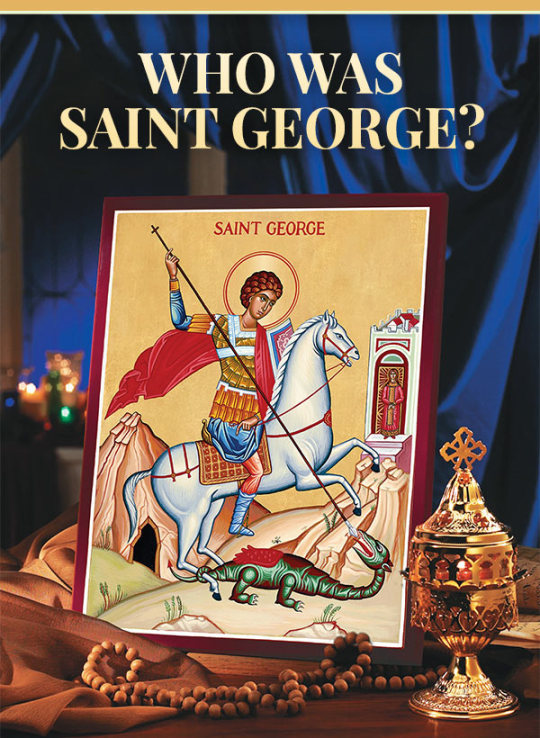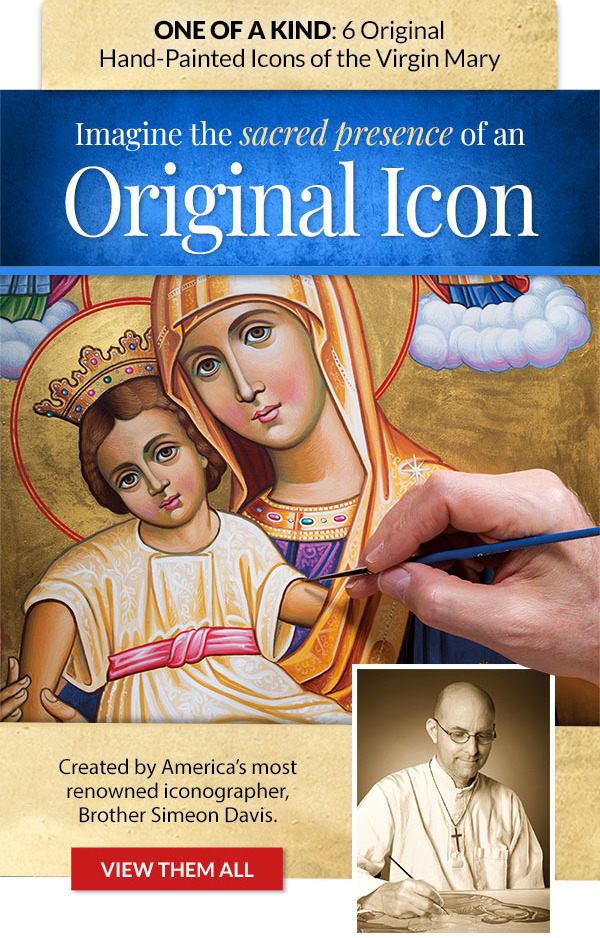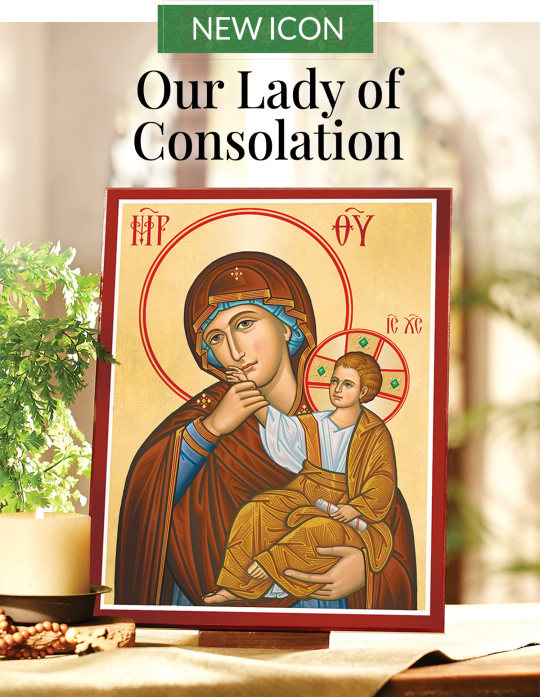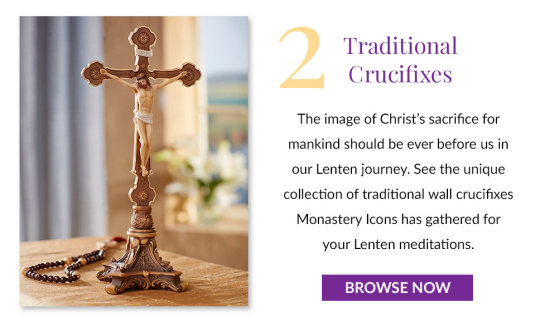Text
Our Lady of Perpetual Help
New Video: The Story of the Most Famous Icon: Our Lady of Perpetual Help
youtube
0 notes
Text

Only $3.95 Shipping During This Week’s Mother’s Day Sale!
Use promo code 395MOM at checkout.
#MothersDayGiftIdeas#mothersdaygifts#motherslove#iconography#icons#catholic#art#church#orthodox#sale#virginmary
0 notes
Text

Who Was Saint George?
Venerated as a beloved protector of Christians since ancient times, Saint George is the patron saint of England, Greece, Russia, Portugal, and Palestine, and of course Georgia. His miraculous and prompt responses to the prayers of Christians in need earned him the title "the Quick to Hear" among Orthodox Christians, and, more simply, "the Great." There are over 200 churches in Egypt named after him. His feast day is April 23rd.
Other than his legendary battle with the dragon, few Christians know much about his life and heroic testimony for the Christian faith.
Born of Christian parents in Cappadocia (present-day Turkey) in the third century, he rose to the rank of tribune in the Roman army. When the Emperor Diocletian issued his edict expelling all Christian soldiers from the army and forcing all Roman soldiers to make sacrifice to the pagan gods, Saint George denounced the edict in front of his fellow soldiers and tore it up. He liberated his slaves, distributed his wealth and prepared for martyrdom. Unable to persuade the saint by promises of wealth and land, the Emperor had him imprisoned and tortured, and then dragged through the streets to be beheaded. His example so inspired the Emperor's wife that she too professed Christ and traded her earthly crown for the crown of martyrdom.
What about the dragon?
The story of Saint George and the dragon was first popularized by the Crusaders, who heard it from Orthodox Christians during their travels in the Middle East. Passing by the city of Silene in Libya, Saint George learned about a dragon, described as a winged crocodile, that was harming the city. To protect themselves from harm the townspeople fed the dragon with a daily offering of two sheep.
The existence of such a beast is not necessarily the stuff of myth and Tolkien. The Latin and Greek words from which we get "dragon" refer to any great serpent. And even in our own times humans have been threatened and even eaten by large serpents or crocodiles.
When the dragon's appetite was not satiated, the people of the city began sacrificing human beings to it, chosen by lot. At the time of Saint George's visit the lot had fallen to a local princess. Invoking the aid of Christ, Saint George vanquished the beast and freed the princess. His conquest of the dragon stands as an archetype for courage and victory in the battle against evil.
Saint George willed his estate to the Church in Jerusalem. In our own times, the wine used by the patriarch of Jerusalem is made exclusively from the grapes of Saint George's vineyard. Pilgrims in the Holy Land can visit the Church of Saint George at Lydda in Palestine, which houses the saint's relics and the chains with which he was bound, which are said to free afflicted souls from demonic possession.
Our icon of Saint George is available as plaques and prints in sizes from 4 inches to 5 feet tall.
/
4 notes
·
View notes
Text

Saint Joseph Builds the Nuns a Staircase in Santa Fe
When the Loretto Chapel of the Sisters of Loretto in Santa Fe, New Mexico was completed in 1878, there was no way to access the choir loft twenty-two feet above. Carpenters were called in to address the problem, but they all concluded access to the loft would have to be via ladder – completely impractical for the sisters – as a staircase would interfere with the interior space of the small Chapel.
To find a solution to the seating problem, the Sisters of the Chapel made a novena to Saint Joseph, the patron saint of carpenters, placing the construction under his care. On the completion of the novena an old, gray-haired, gray-bearded man appeared, leading his donkey and carrying a simple tool collection of a saw, a carpenter’s square, and a hammer. Months later the elegant circular staircase was completed, and the carpenter disappeared without pay or thanks. After searching for the man (an ad even ran in the local newspaper) and finding no trace of him, some concluded that he was Saint Joseph himself, having come in answer to the sisters' prayers.
The stairway is not only magnificent, it is also miraculous. The design was innovative for the time, and even today experts cannot explain the miraculous strength of its construction. The staircase has two 360 degree turns and no visible means of support. It is said that the staircase was built without nails—only wooden pegs. In 1996 a wood technologist completed a study of the wood used for the staircase and reported it was a species of spruce heretofore unknown, with unique square-shaped structure cells.
Over the years thousands have flocked to the Loretto Chapel to see the Miraculous Staircase. The staircase has been the subject of many articles, TV specials, and movies including "Unsolved Mysteries" and the full-length movie titled "The Staircase", starring William Petersen and Barbara Hershey.
See our icon of St. Joseph the Worker here:
1 note
·
View note
Text

ORIGINAL HAND PAINTED ICONS
Over the past 41 years, Brother Simeon’s devoted and prayerful labor of love has given birth to over 300 classical icons of the most beloved themes in Christian liturgical art, treasured in thousands of homes and churches throughout the country. His original works radiate an aura, depth and vitality that even surpasses our beautiful icon plaques. Their vivid detail and rich colors give an unsurpassed testimony to the timeless appeal of the original tradition of Christian art.
Now you can experience the blessing of his priceless original works for yourself. Whether as a memorial donation to your church or the new centerpiece in your home shrine or altar, for decades to come these luminous “windows into heaven” will raise the minds and hearts of all who behold them.
0 notes
Text

Monastery Icons Easter Clearance Sale
Limited Inventory - Don't Miss This Opportunity!
Enter promo code: EASTER60 in your shopping cart to get these savings.
https://www.monasteryicons.com/category/pre-easter-sale
0 notes
Text

A NEW CUSTOMER FAVORITE, the demand for this extraordinary egg has exceeded our supply. But our artist is making more of these, which we expect to have in early May.
Handcrafted in exquisitely detailed artificial stone by artist Gaius Kilmetov, this museum-quality Easter egg features a traditional Byzantine-style icon of the Resurrection on one side, and the scene of the Crucifixion on the other. Self-standing, approximately 4 1/2" tall.
SHIPPED FREE!
To reserve your egg in this limited new inventory, ORDER TODAY.
1 note
·
View note
Text

Watch "The Passion of Christ in Iconography" here:
https://www.monasteryicons.com/product/passion-of-christ-in-iconography/
0 notes
Text

NEW Fine Art Easter Ostrich Egg from Ukraine
Another customer favorite for Easter this year is the Fine Art Easter Ostrich Egg from Ukraine. The demand for this exquisite egg has been more than our Ukrainian artist can keep up with.
But she is creating and shipping more of these, which we expect to have in stock sometime in late April, depending on the time in transit from Ukraine.
Under the hand of Paraska Plytorak, our master artist in Ukraine, the ancient craft of Pysanky eggs becomes fine art. Created on a real ostrich eggshell and decorated in painstaking detail by the traditional method of applying hot beeswax with a stylus and then dipping the egg in various dyes.
Approximately 6 1/4" long, 5 1/8 " diameter. Wooden display stand included.
Find out more here:
https://www.monasteryicons.com/product/Fine-Art-Easter-Ostrich-Egg/
0 notes
Text

For Saint Patrick's Day, celebrate with this icons of the Saints of Ireland.
5 notes
·
View notes
Text

Our Lady of Consolation Icon
The original icon of Our Lady of Consolation is held in honor at the Vatopedi Monastery on Mount Athos. It originated from a miracle that occurred when the son of Emperor Theodosius the Great fell off a ship and into the sea. By the miraculous intercession of the Blessed Virgin, he was carried safely to shore unharmed and found sleeping in a bush, not far from the monastery. In recognition of this miracle her icon was painted and is today displayed at Vatopedi.
www.monasteryicons.com/product/Our-Lady-of-Consolation-Icon/
0 notes
Text

The original icon of Our Lady of Consolation is held in honor at the Vatopedi Monastery on Mount Athos. It originated from a miracle that occurred when the son of Emperor Theodosius the Great fell off a ship and into the sea. By the miraculous intercession of the Blessed Virgin, he was carried safely to shore unharmed and found sleeping in a bush, not far from the monastery. In recognition of this miracle her icon was painted and is today displayed at Vatopedi.
#virginmary #iconography #miracles
0 notes
Text

Follow the Lord's journey through Holy Week to the Resurrection and to Pentecost through these colorful and classic images of the great events of Lent and Easter.
0 notes
Text

Religion Could Be A Miracle Drug - Church attendance is correlated with longer life and a sense of meaning.
If one could conceive of a single elixir to improve the physical and mental health of millions of Americans — at no personal cost — what value would our society place on it?
Going a step further, if research quite conclusively showed that when consumed just once a week, this concoction would reduce mortality by 20% to 30% over a 15-year period, how urgently would we want to make it publicly available? The good news is that this miracle drug — religion, and more specifically, regular church attendance — is already in reach of most Americans. In fact, there’s a good chance it’s just a short drive away.
Indeed, health and religion are very much connected. Professor VanderWeele’s new research with colleagues at Harvard University — building on more than 20 years of prior work in this area — suggests that attending religious services brings about better physical and mental health. Adults who do so at least once a week versus not at all have been shown to have a significantly lower risk of dying over the next decade and a half. The results have been replicated in enough studies and populations to be considered quite reliable.
This science does not endorse one faith over another or suggest what society is to do with such information. But there are two opportunities — one societal and one personal — for good to come from this work. The news media, the academy and the broader public could use this new understanding to weigh religion’s greater societal value. And for individuals, this research provides a not-so-subtle invitation to reconsider what religion can do for them.
The Health Benefits
Nearly half of the country — roughly 2 in 5 Americans — reports having attended a religious service in the past week. The draw for many may be meaningful liturgy, perhaps a sense of forgiveness and ultimately, salvation. Few would say they come for good health. Why might attending services improve one’s health? The Nurses' Health Study finds that social support is critical, yet this accounts for only about a quarter of the effect. Other mechanisms seem to be important as well, possibly due to behavioral norms at services. For instance, those attending are less likely to smoke, or more likely to quit altogether, producing significant health benefits.
Religious service attendance affects mental health, too. The research at Harvard and elsewhere indicates that, possibly due to a message of faith or hope, those who attend services are more optimistic and have lower rates of depression. The research from Harvard has also shown that attendance protects against suicide. Others have found that churchgoers report having a greater purpose in life and develop more self-control — both mechanisms by which service attendance might affect health.
Today, a greater percentage of Americans are choosing no religion at all, and we are witnessing the erosion of religious institutions. For some, church attendance is seen as quaint and outdated, and “spirituality” has become a code word for, “No thanks, I’m sleeping in on Sunday.” What this go-it-alone movement will usher out, it seems, is the benefits of being in the pews. After all, the research has shown that service attendance, rather than private spirituality or solitary practice, strongly predicts health. Something about communal religious participation appears to be essential.
Religion’s Better Angels
What to make of all this? First, the associations between religion and health should force us to reevaluate religion’s role in society and public life. Religion is often perceived negatively today, and at times it’s well earned. But the effects of religious participation are often profoundly positive, a point too often neglected or ignored. The health benefits can be added to a long list of virtues found with an active religious life.
Attending religious services has been shown to increase the likelihood of a stable marriage, to elevate one’s sense of meaning, and to expand one’s social network. It leads to greater charitable giving and more robust volunteering and civic engagement. The effects are profound across numerous domains of life. This has important implications for the extent to which society promotes and protects religious institutions, the maintenance of their nonprofit tax-exempt status, and how the contribution of such institutions is portrayed in the media, the academy, and beyond.
Who could possibly conceive of such an elixir, one that stands to change society in ways small and large, subtle and profound? We’ll leave that question to a higher power.
by Tyler J. VanderWeele of Harvard University and John Siniff
1 note
·
View note
Text

A Third Way to Deepen & Focus your prayer life this Lent:
Icons of the Holy Angels
Explore our selection:
0 notes
Text

The second of 7 Ways to Deepen and Focus your prayer life this lent: Traditional Crucifixes
https://www.monasteryicons.com/category/wall-crosses
0 notes
Text

The first of 7 ways to Deepen & Focus your prayer life this Lent:
1 note
·
View note